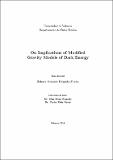Por favor, use este identificador para citar o enlazar a este item:
http://hdl.handle.net/10261/112269COMPARTIR / EXPORTAR:
 SHARE
BASE SHARE
BASE
|
|
| Visualizar otros formatos: MARC | Dublin Core | RDF | ORE | MODS | METS | DIDL | DATACITE | |

| Título: | On implications of modified gravity models of dark energy |
Autor: | Gironés, Zahara CSIC | Director: | Peña-Garay, Carlos CSIC ORCID; Mena, Olga CSIC ORCID | Fecha de publicación: | 19-dic-2014 | Editor: | CSIC-UV - Instituto de Física Corpuscular (IFIC) | Resumen: | Modern cosmology aims to model the large scale structure and dynamics of the universe, and its origin and fate. It was born as a quantitative science after the advent of Einstein’s theory of General Relativity (GR) in 1915. Soon after, GR found its first empirical verification in its successful prediction of two solar system phenomena: the perihelion precession of Mercury and the deflection of light by the Sun. Since then, GR has become an essential tool in the study of astrophysical and cosmological phenomena. According to GR, the energy and momentum of matter are the source of the gravitational field, and at large scales determine the geometry of the universe. In particular, Einstein studied solutions of the GR field equations for a homogeneous distribution of matter, as a model of the large scale structure of the universe. He discovered soon that his theory, in its simplest form, does not support a static universe, but instead predicts an expanding or a contracting one. By contrast, the small velocities of the stars observed at that time suggested that the universe is stationary. In order to allow for a steady-state solution, Einstein had to add what came to be called the cosmological constant to the field equations of GR. The dynamics of a homogeneous and isotropic universe according to GR was subsequently studied more systematically by Alexander Friedmann in 1922, again finding expanding or contracting solutions. In parallel, Edwin Hubble discovered the existence of galaxies outside of the Milky Way, which until then was believed to comprise the entire universe. His subsequent observations showed, in 1929, that the recessional velocity of galaxies increases with their distance from the Earth, implying that the universe is expanding. In consequence, Einstein dropped the cosmological constant from the field equations, famously regretting his ad hoc hypothesis of the universe being static as his “greatest blunder.” However, from a quantum field theory perspective, the cosmological constant in fact arises naturally as the energy density of the vacuum; due to the quantum uncertainty principle, the ground state energy of all matter fields is nonzero, and contributes to the vacuum energy density, acting like a cosmological constant for the gravitational field. | Descripción: | 152 páginas. Tesis Doctoral del Departamento de Física Teórica de la Universidad de Valencia y del Instituto de Física Corpuscular (IFIC). | URI: | http://hdl.handle.net/10261/112269 |
| Aparece en las colecciones: | (IFIC) Tesis |
Ficheros en este ítem:
| Fichero | Descripción | Tamaño | Formato | |
|---|---|---|---|---|
| zgirones-thesis.pdf | 2,92 MB | Adobe PDF |  Visualizar/Abrir |
CORE Recommender
Page view(s)
270
checked on 18-abr-2024
Download(s)
417
checked on 18-abr-2024
Google ScholarTM
Check
NOTA: Los ítems de Digital.CSIC están protegidos por copyright, con todos los derechos reservados, a menos que se indique lo contrario.
